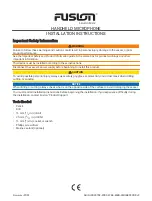
3. Be certain that the input channel fader or volume control is set to minimum before plugging
in any microphone. Preamplifier gain trim should be set to minimum. Plug the microphone
into the cable and activate the phantom power switch. The microphone’s electronics will
stabilize in a few seconds.
4. When the microphone becomes operational, bring the channel fader to 0-dB (unity) and use
the trim to set desired level. This technique maximizes the signal-to-noise performance of the
preamplifier or console input channel.
5. When disconnecting the microphone, bring the channel fader down and unplug the
microphone from the cable. It is also advisable to deactivate the phantom power switch
before unplugging the microphone whenever possible.
6. If the studio has the microphone lines brought to a patch bay (tie lines), never crosspatch a
microphone line when phantom is applied or the monitor volume is raised. This could cause
damage to your microphone, preamplifier or monitor speakers.
Operation
There are a few important facts about ribbon microphones that are key in understanding how to
use them intelligently.
1. The R-122 is a side address, bi-directional microphone and its rejection in the “dead” areas is
very strong. Due to this directionality, the R-122 should be placed at 1.3 times the distance
normally used with omni-directional microphones, or at about the same distance used for
cardioid microphones. This method is used to achieve the same ratio of direct to reflected
sound.
2. In the horizontal plane, the R-122 does not discriminate against the highs off axis; nor does it
boost highs on axis. Therefore, several instruments or vocalists can be placed in front of the
microphone without favoring the performer positioned in the center of the group.
Several performers can be grouped at both the front and back of the microphone, with one
proviso: since the outputs are out of phase at the front and back of the microphone,
cancellation can result if, for example, two tenors are placed at opposite sides at equal
distances and they are singing in unison, so listen to the feed before committing to it.
3. When using the R-122 to record loud signal sources, placing the microphone slightly off axis
relative to the signal source (either horizontally or vertically) minimizes the effect of high
pressure sound levels displacing and possibly damaging the ribbon element.
4. Never attempt to “test” the R-122 or any ribbon microphone with an ohmmeter or continuity
tester. On an active microphone, damage to the delicate electronics could occur; on a passive
ribbon microphone, a blown ribbon could result.
6





































